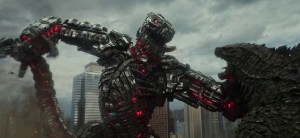The Flash returned for its fifth season and took its audience on a tour through its own history, using point-of-view characters Nora Allen (the outsider who knows everything, including stuff our heroes don’t) and Ralph Dibny (the insider who has remained ignorant of a surprising amount).
Videos by ComicBook.com
It’s a fun journey into the show’s mythology, and feels like it could have been repurposed for a hundredth episode (which comes up later this season).
But what did we notice in the episode that you might have missed? Or at least that you probably geeked out over?
..Well, quite a bit. Let’s play back the tape!
Nora West-Allen
Nora apparently uses her mother’s hyphenated name, which is interesting for a few reasons.
First of all, the shipping community have latched onto “West-Allen” for a long while now. Second, and more significantly, there has been a lot of talk about animosity or at least a strained relationship between Nora and her mother. This suggests that it has not always been that way.
Having seen the episode in full, the obvious explanation is that she doesn’t see any sense of urgency in getting to know Iris, as opposed to Barry, who she wants to spend every available moment with.
Marty McFly
Describing the anomalies XS could create, Barry says that “she could Marty McFly herself out of existence,” a nod to Back to the Future, in which a time-traveling teenager inadvertently impacts his parents’ destiny and ends up nearly eliminating their relationship (along with himself and his siblings) from existence.
This could ultimately be a bit of foreshadowing, since at the end of Back to the Future, they successfully found a way to “fix” Marty’s parents’ lives without breaking the timeline too badly. That is, basically, what XS is there for.
That Iris thinks Marty is from Terminator 2 is a whole, separate issue. Given how often The Flash and Legends of Tomorrow make references to Back to the Future, one would assume she had seen it by now.
Wardobe Choices
There are a ton of callbacks to the first four seasons of the show in this episode; it is appropriate that XS is a Flash super-fan, because obviously that is who “Nora” was written for.
One of the more subtle nods was training Nora in the Speed Lab and having her show up in the STAR Labs shirt, a variation on the wardrobe that Barry and Wally both wore when they were first testing out their speed on the show.
Legends
While DC’s Legends of Tomorrow is the odd show out a lot of the time, this episode nicely referenced it on several occasions.
The first — when Wally takes a look at Nora’s DNA and heads to the Waverider for intel — is punctuated by a subtle music cue that sounds like it sampled the Legends theme music.
Later, another musical note (heh): Wally shares one of his adventures with the Legends with Joe, who is astounded to learn that his son met Elvis Presley (in “Amazing Grace,” last season). That same scene also explains why Wally (in-story, at least) will be leaving The Flash and Legends of Tomorrow soon.
Happy Harbor
This is not the first time (or the fifth, or probably the tenth) that The Flash and other Arrowverse shows have referenced Happy Harbor.
Gridlock
Promotional photos for tonight’s premiere previously revealed that Nora (Jessica Parker Kennedy) and Barry (Grant Gustin) would team up to take on Gridlock, a character that might be somewhat familiar to some DC Comics fans.
In comics, Gridlock is Abner Girdler, a man who worked as an urban planning and new transportation technology specialist for Technodyne, but when his proposed monorail project was scrapped at the last minute by transportation commissioner Clifton Burdett, Girdler lost his job — but gained a serious grudge in the process.
When Burdett later ran for mayor, Girdler moved to sabotage the election under the guise of Gridlock. Girdler used technology to allow him to steal kinetic energy from people and objects, a move that would bring them to a full standstill for an hour. Gridlock manages to freeze most of the city of Manchester, Alabama as well as kidnap his former boss before ultimately being defeated by Impulse. A version of Gridlock — at least one with the same powers — also appeared in 2015’s Bat-Mite.
The Flash‘s take on Gridlock draws on the idea of kinetic energy manipulation but other than that is a dramatically different character. Television’s Gridlock is William Lang, a carjacker who has the ability to absorb kinetic energy and then use it himself. The powers have helped him move beyond carjacking as well, as he’s seen robbing an armored car early in the episode before using the kinetic energy to super punch the Flash. However, while The CW‘s Gridlock isn’t that close of a match to the comics version his last name is of interest as it is also the last name of a character most commonly associated with Superman — Lana Lang.
Grife
“Grife” is an expletive used by characters from DC’s future.
Most commonly associated with the Legion of Super-Heroes, other time-travelers like Rip Hunter have been known to use it from time to time.
This, combined with another reference to the Legion later in the episode, suggests that XS spent some time in the 31st Century, where her comic book counterpart spends most of her time.
The Flash Museum
The Flash Museum, long a fixture in the comics, has been seen on the show before: it debuted in the same season one episode that saw Barry running through the timestream and seeing things like the 1990 The Flash series, a Legion of Super-Heroes ring on a pedastal in Superman’s Fortress of Solitude, and more.
In addition to the Flash Museum itself, XS mentions the curator, Dexter Myles, who was an actor given the job of curating the museum after he helped foil a robbery.
Worlds Finest
A few kind of sly references back to “Worlds Finest,” the episode in which The Flash and Supergirl first crossed over, find their way into the episode.
The tachyon absorption enhancer is actually called out as the one Barry wore when meeting Supergirl for the first time, but even beyond that there are a few nods.
The repeated motif of going out for ice cream was likely a nod to “Worlds Finest,” in which Barry showed Team Supergirl what his powers were by getting them all ice cream cones in an instant.
When Ralph figures out that alternate timelines could create a multiverse, he wheels out a whiteboard to explain his theory in a twist on the scene where Barry explains the theory of the multiverse to Supergirl and company.
Lightning Lad
Here’s that other Legion reference we were talking about.
A founding member of the Legion of Super-Heroes but not one seen so far on Supergirl, Lightning Lad was one of the three Legionnaires who made their way to Smallville in the Geoff Johns-written episode “Legion.” A character with lightning powers, he gets name-dropped in this episode when XS is comparing different kinds of lightning created by superheroes.
Schway

Another piece of future slang — although this one is not from a world where XS is regularly spotted.
“Schway” is basically — as it’s used in this episode — “cool.” But it’s from Batman Beyond, a series set a generation in our future and featuring Terry McGinnis as a young Batman being trained by an aging Bruce Wayne.
While XS is usually seen in the far future in the comics, reinventing her as Barry’s daughter who grew up immediatley following the events of the Crisis means that her timeline would match up with Terry’s pretty seamlessly.
Negative Speed Force

The Negative Tachyons here seem to suggest that the show might be introducing the Negative Speed Force, something with ties to a number of speedsters that has been a significant factor in recent comic book stories.
Crisis on Infinite Earths

In the series pilot, The Flash teased the death of Barry Allen in Crisis on Infinite Earths, which executive producer Greg Berlanti had said was his favorite storyline ever.
It seems that tease is finally coming into play, as Barry’s daughter has come back to this moment in the hopes of nudging the timeline enough to save her father from his disappearance in Crisis.
“Remember to Say ‘I Do’”
After all of the over-analyzing that we and everyone else did last year about the importance of Nora telling her father “remember to say ‘I do,’” the answer is…
…she’s really awkward and that’s all she could thin of to say on his wedding day.
Phasing
“I don’t even know how to phase yet,” Nora tells Barry, setting up another scene that calls back to the first season.
But arguably more important than that callback? Phasing is a power that is apparently quite difficult to master.
Yes, Barry had trouble with it early on, but in the comics, it was years before Wally West ever figured it out — and it came long after he had eclipsed Barry’s accomplishments in most other areas of his powers.
Flash ring
In the comics, Barry Allen usually stored his costume inside of a ring, where it was hypercompressed and would pop out so that he could change into it at super-speed when needed.
On TV, up to this point, the costume has always been hanging in STAR Labs, where Barry could whoosh in and grab it at a moment’s notice. A ring-stored costume has been spotted — – on the Reverse-Flash in season one.
Fans have been wondering about when Barry would get his for years — and now they have their answer.
Ryan Choi
Ryan Choi, an Ivy University student who followed in the footsteps of Ray Palmer to become The Atom, was name-dropped in the episode as the one who designed Barry’s new suit.
Cisco ain’t even mad — he likes the look.
Fixed Time
The idea of “fixed time” is something that comes up in a number of DC time travel stories. It was vocalized pretty clearly during Geoff Johns’s run on Booster Gold, when the title hero tried to save Barbara Gordon from being paralyzed by The Joker only to be told by Rip Hunter that the moment was solid time and would resist being changed.
Of course, even fixed moments in time can be changed given the right nudge, or by going back to before they happened and messing with more malleable moments that led up to them.
“Our Happy Ending”

When Iris says that she and Barry get their “happy ending” and Barry has to withhold important information from her, it feels like a reflection of what happened to the original Wally West in the comics.
After having kids, he decided to retire and settle down, leaving the mantle of The Flash to Bart Allen in one of the most touching superhero sendoffs of all time.
Of course, nobody really gets happy endings — or even endings — in comics, so Wally was brought back after Bart died and had to return to being The Flash. His wife and kids were eventually written out of continuity following the events of Flashpoint and Wally himself was killed in Heroes in Crisis.
Cameron Mahkent?

It was difficult to discern the name of the fake doctor on Caitlin’s father’s death certificate, but we thought it sounded like “Cameron Machund.”
That led our brain straight to Cameron Mahkent, who besides looking like “Ma Kent” is his last name is also a DC supervillain (and occasional antihero) known as the Icicle.
Given that the villain is one with ice powers (and who briefly teamed up with Killer Frost in the comics), it seems unlikely this is a coincidence…although whether her father actually IS a supervillain or whether the writers just tossed that name in as a wink and a nod to the hardcore fans is anybody’s guess.
Cicada

Our big bad came in during the last few moments of the episode.
“His endgame isn’t about The Flash,” executive producer Todd Helbing explained in a previous interview. “It’s more of a bigger-scale issue… A big part of the story of this season [is about] the metas, where they got their powers from, and it’s tied into everybody’s journey this year. Cicada’s powers are different than DeVoe’s [and] any of the speedsters in the way they affect our team.”
Hersch, who was first introduced into the pages of The Flash in 2001, was a Catholic preacher who became consumed by guilt after abusing and murdering his wife. On the brink of committing suicide, Hersch was struck by a bolt of lightning, and was essentially given the power of immortality — as long as he absorbed the life-forces of others. This led Hersch to become consumed with his powers, ultimately forming a cult and taking on the moniker of Cicada. His cult used lightning bolt daggers to murder those who were saved by The Flash.
While it sounds like The Flash’s Cicada might be a little different from his comic counterpart, it sounds like he will pose a unique challenge to Team Flash either way.
“It is nice to have a villain that we can change up what Barry’s obstacle and the team’s obstacles are, and how to take somebody down.” Helbing echoed to ComicBook.com after the Season 4 finale. “The Thinker, DeVoe, [was] a lot of fun and we certain see the benefits of doing that. Having a meta that isn’t a speedster and the new ways that we can pose challenges for those guys is fun. So I think for next season, it’s certainly not going to be a speedster.”









